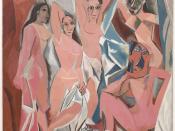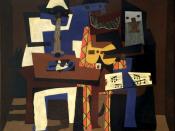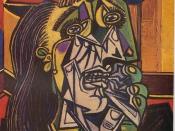In this essay, we were instructed to tell of how the Cubism art movement came to be, as well as how the futurist movement influenced the modernist art that we commonly see today. Using examples, artists and works, I will attempt to link cubism and futurism to modernist art.
Cubism began as an intellectual revolt against the artistic expression of previous eras. In this they were trying to break through the traditional imitation of nature type works that were currently being produced.
In cubist artworks, objects are broken up, analyzed, and re-assembled in an abstracted form - instead of rendering objects from a single fixed angle, the artist depicts the subject from multiple angles simultaneously as an attempt to present the subject in the most complete manner. Often the surfaces of the facets, or planes, intersect at angles that show no recognizable depth. The background and object (or figure) planes interpenetrate one another creating the ambiguous shallow space characteristic of cubism.
It was a complete and clearly defined aesthetic.
Tamon Miki of the National Museum of Modern Art,Tokyo believes that the actual year that the movement began was in 1907. It was in this year that Apollinaire (the poet) introduced Picasso to Braque. It is well known that at that time both artists were influenced greatly by Cezanne.
Picasso and Braque basically started the movement when they followed the advice of Paul Cézanne, who in 1904 said artists should treat nature "in terms of the cylinder, the sphere and the cone."Braque later described his and Picaso's relationship as being like 'two mountaineers roped together'. Picasso's painting of the Les Demoiselles d'Avignon is considered essential in the development of the movement, even though it is not considered to be a cubist work. In the painting, Picasso first experimented with seeing the...


